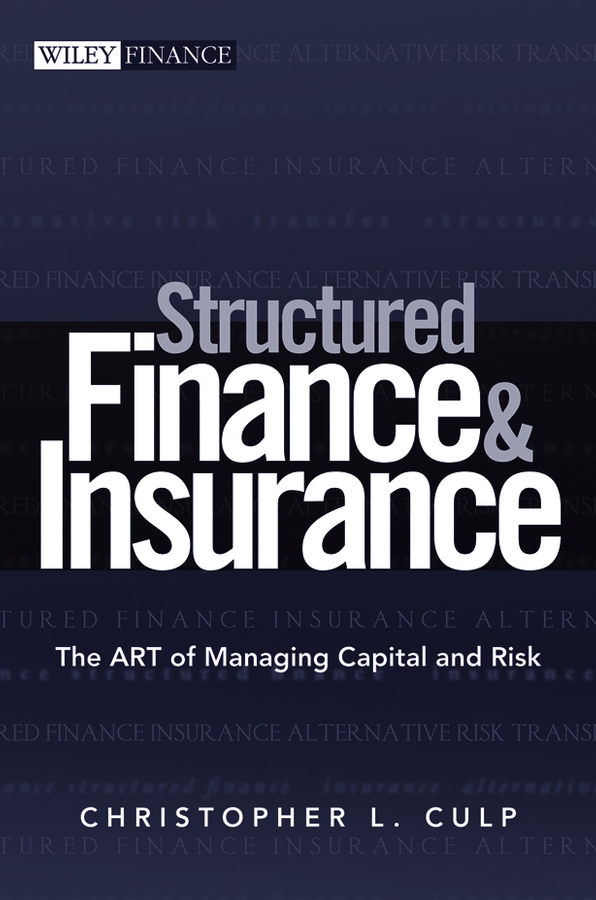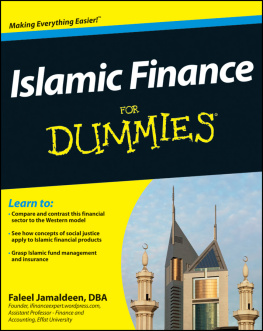Christopher L. Culp - Structured Finance and Insurance
Here you can read online Christopher L. Culp - Structured Finance and Insurance full text of the book (entire story) in english for free. Download pdf and epub, get meaning, cover and reviews about this ebook. year: 2011, publisher: Wiley, genre: Business. Description of the work, (preface) as well as reviews are available. Best literature library LitArk.com created for fans of good reading and offers a wide selection of genres:
Romance novel
Science fiction
Adventure
Detective
Science
History
Home and family
Prose
Art
Politics
Computer
Non-fiction
Religion
Business
Children
Humor
Choose a favorite category and find really read worthwhile books. Enjoy immersion in the world of imagination, feel the emotions of the characters or learn something new for yourself, make an fascinating discovery.

- Book:Structured Finance and Insurance
- Author:
- Publisher:Wiley
- Genre:
- Year:2011
- Rating:4 / 5
- Favourites:Add to favourites
- Your mark:
- 80
- 1
- 2
- 3
- 4
- 5
Structured Finance and Insurance: summary, description and annotation
We offer to read an annotation, description, summary or preface (depends on what the author of the book "Structured Finance and Insurance" wrote himself). If you haven't found the necessary information about the book — write in the comments, we will try to find it.
Structured Finance and Insurance — read online for free the complete book (whole text) full work
Below is the text of the book, divided by pages. System saving the place of the last page read, allows you to conveniently read the book "Structured Finance and Insurance" online for free, without having to search again every time where you left off. Put a bookmark, and you can go to the page where you finished reading at any time.
Font size:
Interval:
Bookmark:

Contents
Founded in 1807, John Wiley & Sons is the oldest independent publishing company in the United States. With offices in North America, Europe, Australia, and Asia, Wiley is globally committed to developing and marketing print and electronic products and services for our customers professional and personal knowledge and understanding.
The Wiley Finance series contains books written specifically for finance and investment professionals as well as sophisticated individual investors and their financial advisors. Book topics range from portfolio management to e-commerce, risk management, financial engineering, valuation, and financial instrument analysis, as well as much more.
For a list of available titles, visit our Web site at www.WileyFinance.com .

Copyright 2006 by Christopher L. Culp. All rights reserved.
Published by John Wiley & Sons, Inc., Hoboken, New Jersey.
Published simultaneously in Canada.
No part of this publication may be reproduced, stored in a retrieval system, or transmitted in any form or by any means, electronic, mechanical, photocopying, recording, scanning, or otherwise, except as permitted under Section 107 or 108 of the 1976 United States Copyright Act, without either the prior written permission of the Publisher, or authorization through payment of the appropriate per-copy fee to the Copyright Clearance Center, Inc., 222 Rosewood Drive, Danvers, MA 01923, (978) 750-8400, fax (978) 646-8600, or on the web at www.copyright.com . Requests to the Publisher for permission should be addressed to the Permissions Department, John Wiley & Sons, Inc., 111 River Street, Hoboken, NJ 07030, (201) 748-6011, fax (201) 748-6008, or online at http://www.wiley.com/go/permissions .
Limit of Liability/Disclaimer of Warranty: While the publisher and author have used their best efforts in preparing this book, they make no representations or warranties with respect to the accuracy or completeness of the contents of this book and specifically disclaim any implied warranties of merchantability or fitness for a particular purpose. No warranty may be created or extended by sales representatives or written sales materials. The advice and strategies contained herein may not be suitable for your situation. You should consult with a professional where appropriate. Neither the publisher nor author shall be liable for any loss of profit or any other commercial damages, including but not limited to special, incidental, consequential, or other damages.
For general information on our other products and services or for technical support, please contact our Customer Care Department within the United States at (800) 762-2974, outside the United States at (317) 572-3993 or fax (317) 572-4002.
Designations used by companies to distinguish their products are often claimed by trademarks. In all instances where the author or publisher is aware of a claim, the product names appear in Initial Capital letters. Readers, however, should contact the appropriate companies for more complete information regarding trademarks and registration.
Wiley also publishes its books in a variety of electronic formats. Some content that appears in print may not be available in electronic books. For more information about Wiley products, visit our web site at www.wiley.com .
Library of Congress Cataloging-in-Publication Data:
Culp, Christopher L.
Structured finance and insurance : the ART of managing capital and risk / by Christopher L. Culp [et al.].
p. cm.(Wiley finance series)
Includes bibliographical references and index.
ISBN-13: 978-0-471-70631-1 (cloth)
ISBN-10: 0-471-70631-0 (cloth)
1. Asset-backed financing. 2. Securities. 3. Risk management. 4. Risk (Insurance). I. Title. II. Series.
HG4028.A84C85 2006
658.155dc22
2005019905
Foreword
Wherefore ART Thou? The Importance of Principle-Based Structured Finance
Whenever I get a chance to speak to one of Chriss MBA classes at the University of Chicago, I enjoy the look on his students faces when I start spouting Shakespeares views on risk management and corporate finance. For practitioners of structured finance and alternative risk transfer (ART), many of his quotes are quite instructive. For example:
Eye of newt, and toe of frog,
Wool of bat, and tongue of dog,
Adders fork, and blind-worms sting,
Lizards leg, and howlets wing,
For a charm of powerful trouble,
Like a hell-broth boil and bubble.
Macbeths witches truly appear to be our first structured finance specialists. At least that is what some may conclude when reading about the efforts of managers and their financial advisers to practice structured finance and ART as a sort of alchemyturning debt into insurance, taking liabilities off balance sheet, or accelerating earnings to cover known losses. We cant bid farewell to magic ( Tempest, Act V, Scene I), but we can establish the fundamentals on which the proper solutions are structured to address fundamental capital and risk management issues.
In Parts One and Two of this book, Chris lays out the building blocks of finance and risk management drawing on corporate finance theory and applied research that has been developed over the past 30 years. These tools are then sharpened in Parts Three and Four as we move from theory to applications involving project finance, securitization, and the convergence between insurance and capital markets solutions such as catastrophe bonds and committed capital. Chris brings together two different worldsthe world of corporate finance and the world of insuranceand explains how the tools, while they may look different, are based on the same fundamentals.
These worlds are complicated on their own. When practitioners bring them together they often create Byzantine structures to address accounting, regulatory, tax, and corporate finance drivers that might lead even the most astute shareholder or analyst to proclaim:
Sir, I am vexed;
Bear with my weakness; my old brain is troubled.
(Tempest, Act IV, Scene I)
This is why simple principles are important. Shakespeares entreaty To thine own self be true ( Hamlet, Act I, Scene III) can be used by any manager to question whether the structured transaction is a means for obscuring or addressing underlying risks. Structured transactionswhether they securitize assets, cover difficult-to-insure risks, or access capital markets investors more efficientlyare of questionable value if management cannot explain clearly why considerable time and resources were spent to structure such solutions.
Often, the decision to structure a solution is a type of To be or not to be question. Does management of an airline company believe its shareholders wish it to be in the transportation business or the fuel speculation business? To what degree should the future oil price be hedged, for how long, and at what cost? Chris explains the fundamental principles to answer these questions and goes one step further by explaining the confusion shareholders face if they do not know or understand managements risk management strategy.
Of course, it is because companies can never be secure from worldly chances and mishaps (Titus Andronicus) that risk management has a role. It is equally important that risk managers understand that shareholders expect management to take risks. Without taking risk, management cannot create value. It is the balancing act between risk and ruin that Chris concentrates on in such detail by keeping our attention focus on both capital and risk management.
Font size:
Interval:
Bookmark:
Similar books «Structured Finance and Insurance»
Look at similar books to Structured Finance and Insurance. We have selected literature similar in name and meaning in the hope of providing readers with more options to find new, interesting, not yet read works.
Discussion, reviews of the book Structured Finance and Insurance and just readers' own opinions. Leave your comments, write what you think about the work, its meaning or the main characters. Specify what exactly you liked and what you didn't like, and why you think so.







